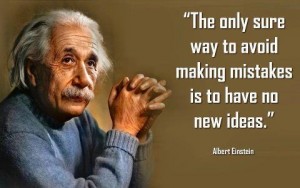Science Seen Physicist and Time One author Colin Gillespie helps you understand your world.
The Origins of Einstein’s Ideas
Albert Einstein is mostly known for physics theories. Or for E=mc2 (though he didn’t write it in that  way). But his biggest contribution was the boldness, number, depth, diversity, originality and sometimes sheer courage of his ideas. Every one of these ideas was controversial at the time; now they underpin the world economy.
way). But his biggest contribution was the boldness, number, depth, diversity, originality and sometimes sheer courage of his ideas. Every one of these ideas was controversial at the time; now they underpin the world economy.
What’s the difference between theories and ideas? Well, for example, the citation for his Nobel Prize says it is for ‘his services to Theoretical Physics, and especially for his discovery of the law of the photoelectric effect’. But the idea behind that theory was the concept of a photon, a quantum of light. Important people ridiculed him for this idea for years. Even his best friends felt a need to apologize. For example, in nominating him for membership in the Prussian Academy of Sciences eight years after that discovery, four prominent physicists wrote:
‘That he may have missed the target in his speculations, as, for example, in his hypothesis of light quanta, cannot really be held too much against him, for it is not possible to introduce really new ideas even in the most exact science without sometimes taking a risk.’
Taking a risk? As I say of this elsewhere: ‘He is a young patent clerk. Newly-wed, he has a new-born child. He’s seeking a career in physics.’ And yet here he is taking on the entire physics establishment.
On the face of it it’s hard to pin down where Einstein stands on many of his theories. His mind moved hither and yon. What’s constant is its change and what’s enduring is his ideas. Famously he invented the idea of a cosmological constant (today aka Dark Energy) and then retracted it, calling it ‘my greatest blunder.’ Now it rules the universe.
There are many less well-known examples. In 1905 he said the idea of an ether was no longer needed; then in 1920 he gave a lecture on ‘Ether and the Theory of Relativity’ saying the idea of an ether is essential and indeed it is what we call space (a fact that even today few physicists seem to know). In 1916 he proposed the existence of gravitational waves; then twenty years later he changed his mind and said that there are none; yes, this is those same waves that were first detected a few days ago.
It’s not like his inconstancy embarrassed him. Writing to a colleague, he says with sly humour,
‘Einstein has it easy. Every year he retracts what he wrote in the preceding year.’
Einstein wrote over 250 scientific papers in German and English. He wrote a huge number of letters and in some of these we find less formal insights into his striving with ideas. All of the scientific papers and most of the letters survive. Long inaccessible, they are becoming freely available to all through the Einstein Archives Online and The Collected Papers of Albert Einstein. An intellectual goldmine is now at our fingertips.
Ideas in his papers range from showing how to demonstrate atoms exist to showing that space must be finite and explaining why time is different for different observers. His letters to thousands of correspondents reveal more ideas ranging over an even wider range of interests – physics and philosophy of course but also such things as politics and music.
So where do new ideas like Einstein’s come from? The answer seems to be simple and extremely complex. They come from old ideas. More precisely, they come from what American psychologist Marc Hauser calls ‘the promiscuous combination of ideas’. For example, who knows from what corner of his mind came that first glimpse that ripened into the idea that the speed of light does not just happen to be constant (as was then widely known) but was a fundamental property of the universe? Maybe even Einstein could not have said for sure, though he was interested in this question too.
The recipe for his penetrating originality thus seems to be: Be curious about the world. By all means study, but not too closely; experience widely. Pursue physics perhaps; but think philosophy.
Sources:
G. Kirsten &H. Körber (1975), Physiker über Physiker, Berlin: Academie Verlag, p. 201; tr. by Abraham Pais (1982), ‘Subtle is the Lord . . .’: The Science and the Life of Albert Einstein, New York: Oxford University Press, p. 382.
Albert Einstein (1915), letter to Paul Ehrenfest, Dec. 26, tr. Ann M. Hentschel, Collected Papers of Albert Einstein: The Berlin Years: Correspondence, 1914-1918, Princeton: Princeton University Press, vol. 8, p. 167; http://einsteinpapers.press.princeton.edu/vol8-trans/195
Marc Hauser (2009), “The Origin of the Mind”, Scientific American, September, p. 44.
Image credit: https://www.pinterest.com/claybaskets/einstein/

No comments yet.